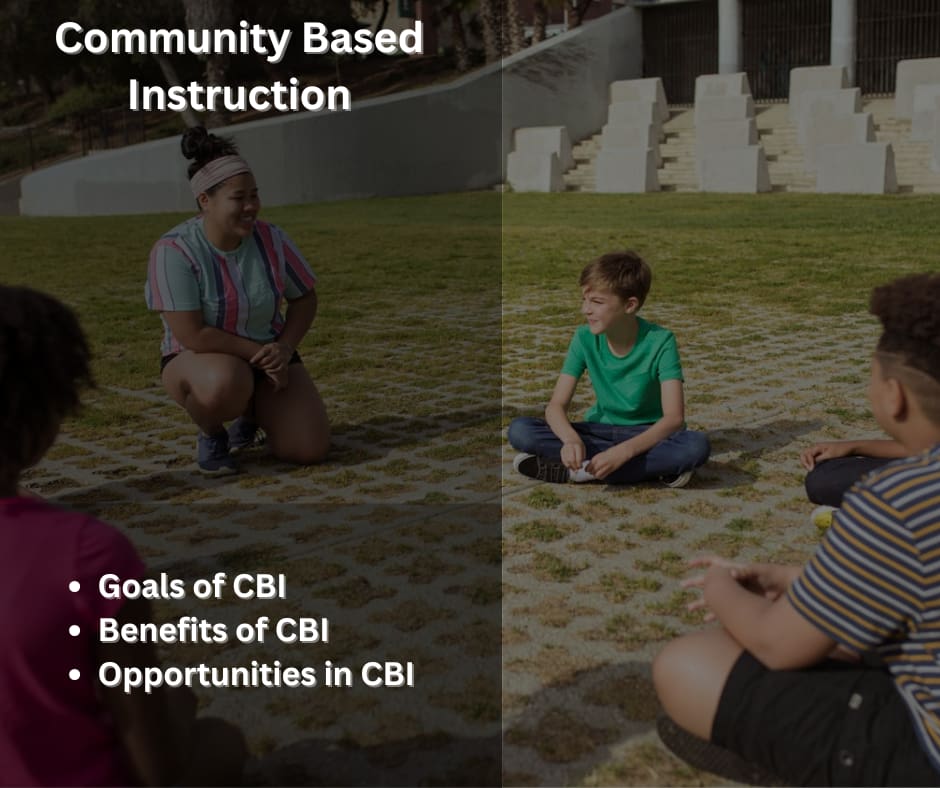In the fast-paced world where technology is getting smarter everyday, we need to brace ourselves up for the same. Community Based Instruction is a very constructive approach in this regard. It offers a powerful approach for teaching real-world skills to students, especially those with special needs. But what exactly is CBI, and why is it so effective?
This blog breaks down the whole idea of Community-Based Instruction, explores its benefits, and offers practical tips for implementing it in your learning environment.

What is Community Based Instruction?
Community Based Instruction (CBI) is an instructional method that takes learning beyond the traditional classroom setup and into real-world community settings. Apparently, it is primarily used in special education to teach key life skills—such as grocery shopping, using public transportation, or banking—in authentic environments where those skills are naturally applied.
Classroom learning focuses on primarily on the theoretical aspects with little emphasis on practical aspects of how to the world works. Consequently, learning is limited to the visual, auditory and reading/writing styles of learning. However, CBI aligns with the idea that students learn best when all their learning inputs are actively engaged in a meaningful way. In a way, it promotes the kinesthetic (learning through doing and experiencing) style of learning, apart from the other styles as well. Rather than simulate activities within the classroom, educators and support staff guide students through tasks in actual community settings.
Core Goals of Community Based Instruction
CBI programs focus on helping people:
- Gain independent living skills
- Improve social interaction and communication
- Practice vocational skills in real workplaces
- Increase confidence and self-advocacy
- Learn to navigate public systems like transportation, libraries, and grocery stores
Who Benefits from Community Based Instruction?
If we consider the education system in general, schools often emphasize heavily on academic subjects such as math, science, and literature. While these subjects are essential, several crucial life skills are often undermined in traditional education. Skills such financial literacy, emotional intelligence, communication & interpersonal skills, critical thinking, legal & civic knowledge are extremely important in practical life. Clearly, CBI can play a role in this. Furthermore, it can benefit any learner who needs support in transitioning from school to independent or semi-independent living.
CBI for Specially-abled People
Besides, CBI is especially effective for students with developmental disabilities or cognitive impairments. It can benefit any learner who needs support in transitioning from school to independent or semi-independent living.
Typical beneficiaries include:
- Transition-aged youth preparing for adulthood
- Students with Autism Spectrum Disorder (ASD)
- Individuals with Intellectual Disabilities (ID)
- Learners on Individualized Education Programs (IEPs)
Opportunities in CBI
Trainers, educators and even instructional designers play essential roles in the successful rollout of CBI. Here’s a brief breakdown on how these professionals can contribute.
(Do check out the opportunities by clicking the link under each role as well)
Community Based Instruction – Role of Trainers
Trainers in Community-Based Instruction (CBI)—such as job coaches, professionals, transition specialists, or vocational trainers—have several unique opportunities for growth, impact, and professional development. Their role is essential in helping learners gain independence and real-world competence.
Hands-On Impact with Learners
- Opportunity to directly support student growth by teaching real-life skills in authentic settings
- Witness tangible progress in learners’ independence, confidence, and skill generalization
Professional Skill Development
- Gain experience in applied behavior analysis, task analysis, data collection, and instructional strategies
- Improve communication, coaching, and problem-solving skills in dynamic, real-world environments
Career Progression
Experience in CBI can open doors to roles such as:
- Transition Coordinator
- Special Education Teacher
- Rehabilitation or Vocational Counselor
- Program Manager for life skills
Community Based Instruction – Role of an Instructional Designer (ID)
The role of an Instructional Designer (ID) in CBI is multifaceted. The goal of an ID is to ensure that educational experiences are meaningful, accessible, and effective in real-world community settings. Here’s a detailed breakdown:
Needs Assessment
- Identify learner needs through collaboration with educators, community partners, and families
- Analyze the skills required for real-life tasks
- Evaluate environmental and cultural factors that influence instruction
Curriculum Design
- Design learning objectives aligned with both educational standards and practical life skills
- Structure content to match real-world tasks and scenarios in community settings
Module Development and Activities
- Create or adapt instructional materials (e.g., task analyses, visual supports, checklists)
- Develop interactive and experiential learning activities that take place in community settings
Training Collaboration
- Work closely with teachers, coaches, therapists, and community members
- Offer professional development to staff on implementing CBI strategies
- Facilitate communication among school, family, and community stakeholders
Implementation Support
- Assist in scheduling and coordinating community visits or on-site instruction
- Observe instruction in real-world settings to offer feedback and refinement
- Ensure instruction is consistent and goal-directed across different environments
Assessment & Evaluation
- Design assessments that measure functional skill acquisition in real contexts
- Collect data on learner progress, engagement, and generalization of skills
- Revise instructional approaches based on data-driven insights
Ensuring Safety and Accessibility
- Ensure all instructional plans consider student safety, supervision needs, and legal requirements
- Promote equitable access to community learning opportunities
An instructional designer in CBI acts as a bridge between educational theory and real-world application, ensuring that learners gain practical, meaningful skills through structured and well-supported community experiences.
How to Implement Community Based Instruction
- Have clear goals: Use the Individualized Education Program (IEP) to identify the life skills that has to be targeted
- Plan the outings carefully: Pre-teach vocabulary, routines, and expectations in a safe classroom setting
- Incorporate data collection tools: Measure progress with observations, checklists, and feedback from community partners
- Encourage family involvement: Persuade caregivers to practice skills at home or in their local neighborhood
- Ensure safety and supervision: All activities must be supervised and the students should understand how to stay safe in public settings
Final Thoughts
Community-Based Instruction is more than just a teaching strategy—it’s a bridge between the classroom and the real world. By immersing students in real-life situations, CBI fosters independence, practical skills, and long-term success that goes beyond the school walls. Finally, CBI is not something new. Interestingly, it’s one of the oldest methods of transferring knowledge.
As they say, if you want to understand something, study it, however, if you want to learn something, experience it. And that’s what CBI does. With CBI, one aims to bridge the gap between schools and the challenges of the real world.
